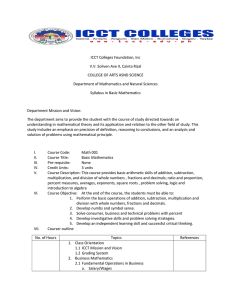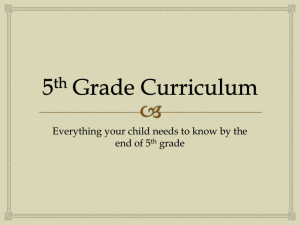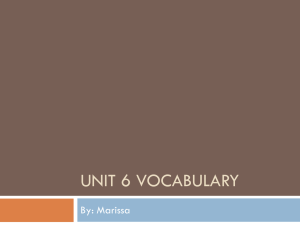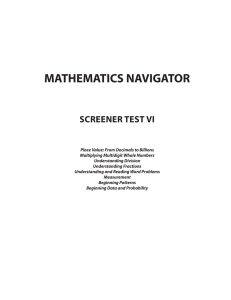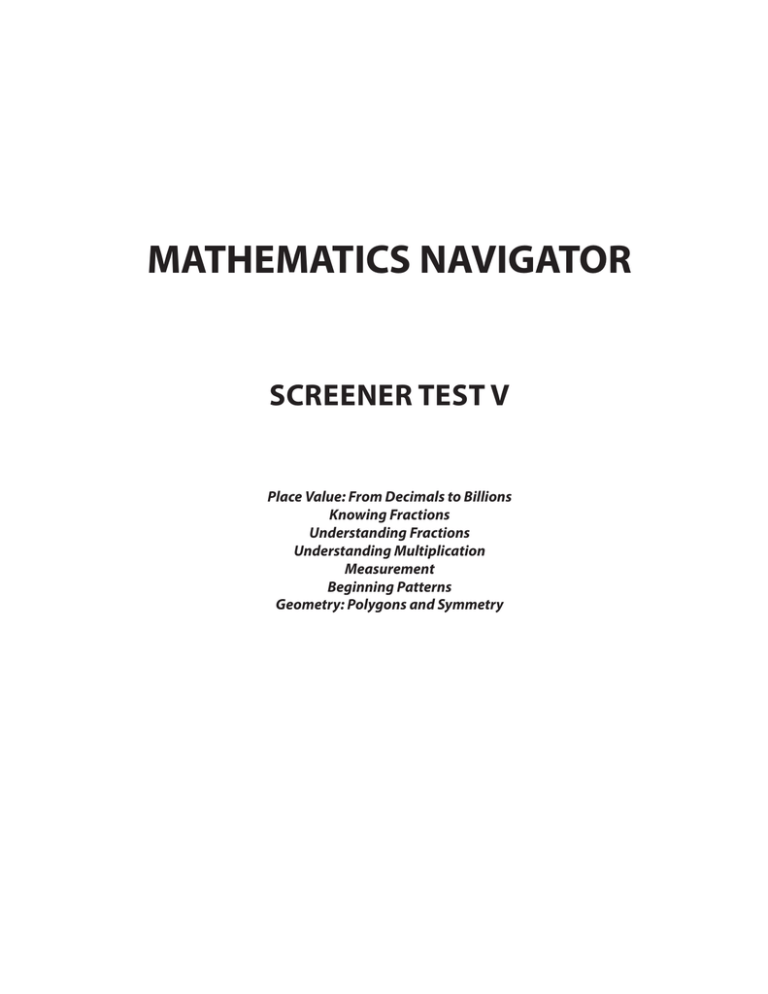
MATHEMATICS NAVIGATOR
Screener Test V
Place Value: From Decimals to Billions
Knowing Fractions
Understanding Fractions
Understanding Multiplication
Measurement
Beginning Patterns
Geometry: Polygons and Symmetry
This Screener Test has been designed to correlate with the NCTM Curriculum Focal Points.
Each Screener Test focuses on three to eight Mathematics Navigator modules, which in turn
focus on addressing misconceptions students may have about mathematics concepts.
Screener Test V is designed to be given at the beginning of the school year. It covers the
standards that students need in order to be successful at their grade level.
The results of this Screener Test will help instructors identify gaps in students’ knowledge and
determine which Mathematics Navigator modules will help fill those gaps. Participation in
these modules will help students succeed in mathematics and on their state assessments tests.
America’s Choice® is a subsidiary of the National Center on Education and the Economy® (NCEE), a Washington, DC-based
non-profit organization and a leader in standards-based reform. In the late 1990s, NCEE launched the America’s Choice School
Design, a comprehensive, standards-based, school-improvement program that serves students through partnerships with states,
school districts, and schools nationwide. In addition to the school design, America’s Choice provides instructional systems in
literacy, mathematics, and school leadership. Consulting services are available to help school leaders build strategies for raising
student performance on a large scale.
© 2009 by America’s Choice
All rights reserved. No part of this publication may be reproduced or transmitted in any form or by any means, electronic or
mechanical, including photocopy, recording, or any information storage and retrieval system without permission from the
America’s Choice permissions department.
America’s Choice and the America’s Choice logo are registered trademarks of America’s Choice. The National Center on
Education and the Economy is a registered trademark of The National Center on Education and the Economy.
First Printing 2009
1 2 3 4 5 6 7 8 9 10 12 11 10 09 08
ISBN 978-1-60637-602-7
http://www.americaschoice.org
e-mail: products@americaschoice.org
Screener Test V
1. How would you write “thirty-one
hundredths of a dollar” as a number?
4.
1
is equal to:
10
A.
$31.00
A.
10
B.
$100.31
B.
1
C.
$3,100
C.
0.1
D.
$0.31
D.
0.01
–––––––––––––––––––––––––––––––––––––––––
2. Which representation is equal
to 413.2?
A.
4,132 tenths
B.
Four hundred and one
hundred thirty-two tenths
C.
D.
Hundreds
Tens
Ones
Tenths
400 + 13 + 2
–––––––––––––––––––––––––––––––––––––––––
3. Mrs. Chi collected a little more than
$63,800 to donate to the Red Cross
Fund, and Mr. Hakim collected almost
$49,300 to donate to the Red Cross
Fund. What is the best estimate of
their total contribution to the Red
Cross Fund?
A.
$67,000
B.
$110,000
C.
$1,012,110
D.
$11,000
–––––––––––––––––––––––––––––––––––––––––
5. If the digit 7 in the number 5.079
stands for 7 hundredths, what does
the digit 9 in the number stand for?
A.
Nine ones
B.
Thousands
C.
Thousandths
D.
Nine thousandths
–––––––––––––––––––––––––––––––––––––––––
6. Arrange the decimals 1.02, 0.2, and
0.12 in order from least to greatest.
A.
1.02, 0.2, 0.12
B.
0.12, 0.2, 1.02
C.
0.2, 1.02, 0.12
D.
0.2, 0.12, 1.02
➥
GO ON
©America’s Choice
Mathematics Navigator
|
Screener Test V
7. What fraction of the area of this
rectangle is shaded?
5
3
A.
B.
5
8
C.
1
2
D.
3
5
–––––––––––––––––––––––––––––––––––––––––
8. Which number is best represented by
point F?
F
9. Three students share 4 bottles of water
equally on a hike. How much does
each student get?
A.
4
bottles
3
B.
1
of a bottle
3
C.
3
of a bottle
4
D.
4.3 bottles
–––––––––––––––––––––––––––––––––––––––––
10. Anna collects stamps. Her
collection contains 45 stamps
from other countries. One-ninth
of the stamps from other countries
come from Mexico.
How many Mexican stamps does
she have?
•
1
0
A.
6
10
B.
7
10
C.
4
6
D.
7
11
A.
1
B.
9
C.
5
D.
45
➥
GO ON
|
Screener Test V
©America’s Choice
Screener Test V
11. Four students plan to share 6
sandwiches equally. How many
sandwiches will each student get?
12. Josh cut a cake and ate
1
of it. Which
8
description matches this situation?
A.
1
1
sandwiches
2
A.
B.
1
of a sandwich
4
Josh cut the cake in 16 equal
pieces and ate 3 of them.
B.
Josh cut the cake in 8 equal
pieces and ate 2 of them.
C.
4
of a sandwich
6
C.
Josh cut the cake in 8 equal
pieces and ate 1 of them.
D.
2
of a sandwich
3
D.
Josh cut the cake in 18 equal
pieces and ate 1 of them.
➥
GO ON
©America’s Choice
Mathematics Navigator
|
Screener Test V
13. Which set of numbers lists these fractions in decimal form?
1 2 3
, ,
4 4 4
A.
0.1, 0.2, 0.3
B.
0.5, 0.6, 0.7
C.
0.25, 0.5, 0.75
D.
1.4, 2.4, 3.4
–––––––––––––––––––––––––––––––––––––––––––––––––––––––––––––––––––––––––––––––––––––
14. Arrange these fractions in order from least to greatest.
7 7
1 11
, ,1 ,
8 4 2 16
Use this ruler to help you solve this problem.
0
1
2
3
4
5
6
1 7 7 11
, , ,
2 4 8 16
A.
1
B.
11 7
1 7
, ,1 ,
16 8 2 4
C.
7 11 7
1
,
, ,1
8 16 4 2
D.
7
1 7 11
,1 , ,
4 2 8 16
➥
GO ON
|
Screener Test V
©America’s Choice
Screener Test V
15. Miguel had the right answer for 9 of
the 15 homework problems. Which
statement best describes his work?
18. Arrange these numbers in order from
least to greatest.
9
14
, 0.53,
, 1.02
10
29
A.
Miguel got all of his
homework right.
B.
Miguel got almost all of his
homework right.
A.
0.53,
14 9
,
, 1.02
29 10
C.
Miguel got about half of his
homework right.
B.
1.02,
9 14
,
, 0.53
10 29
D.
Miguel got almost none of his
homework right.
C.
14
9
, 0.53,
, 1.02
29
10
D.
9 14
,
, 0.53, 1.02
10 29
–––––––––––––––––––––––––––––––––––––––––
16. What number does Point B represent?
B
0
2
1
A.
3.2
B.
3.25
C.
3.4
D.
3 + 2.5
3
•
4
–––––––––––––––––––––––––––––––––––––––––
17. Which numbers are all closer to 0 than
to 1?
A.
7
, 2.15, 0.98
8
B.
0.98,
C.
1
3
,
, 0.804
200 30
D.
0.006,
©America’s Choice
–––––––––––––––––––––––––––––––––––––––––
19. Which of these sets includes numbers
that are all multiples of 3?
A.
33, 66, 78, 99
B.
15, 18, 21, 23
C.
6, 12, 33, 73
D.
1, 3, 6, 9
1 2
,
3 15
3
1
,
32 150
➥
GO ON
Mathematics Navigator
|
Screener Test V
20. Anna sketched a plan for her garden
before planting. See the array below.
21. Which division equation is equivalent
to this equation?
3 • 7 = 21
She planted 7 rows with 14 plants in
each row. How many plants did Anna
plant altogether?
If a student used the distributive
property to solve this problem, which
solution would be correct?
A.
7 × 14 = (7 × 4) + (7 × 9)
B.
7 × 14 = (7 × 8) + (7 × 7)
C.
7 × 14 = (7 × 6) + (7 × 7)
D.
7 × 14 =(7 × 10) + (7 × 4)
A.
21 = 7 ÷ 3
B.
3 = 7 ÷ 21
C.
7 = 3 ÷ 21
D.
21 ÷ 7 = 3
–––––––––––––––––––––––––––––––––––––––––
22. In which box do all the rows give the
same answer?
A.
3+3+3+3
5 groups of 3
3×5
15
B.
7+7+7+7
4 groups of 7
4×7
7×4
C.
9+9+9
Three nines
9×3
28
D.
4
1 group of 4
four fours
4 groups of 1
➥
GO ON
|
Screener Test V
©America’s Choice
Screener Test V
23. Tamika has five times as many trading
cards as Gabby.
Gabby has 18 trading cards.
What is the best estimate of the
number of trading cards Tamika has?
25. If the length of a rectangular lawn is
12 meters and its width is 60 meters,
which expression could be used to
find the area of the lawn?
A.
(60 + 60) + (12 + 12)
A.
4 trading cards
B.
60 × 12
B.
100 trading cards
C.
60 + 12
C.
25 trading cards
D.
60 ÷ 12
D.
180 trading cards
–––––––––––––––––––––––––––––––––––––––––
24. Malaya delivers papers. She is paid
$16 for each box of 300 papers she
delivers. How much will Malaya earn
if she delivers 6 boxes of papers?
If a student used doubling and halving
as a method to solve this problem,
which solution would be correct?
A.
6 × 8 = 48
B.
12 × 32 = 384
C.
150 × 32 = 4,800
D.
12 × 8 = 96
–––––––––––––––––––––––––––––––––––––––––
26. Which pair of measurements shows
the dimensions of two rectangles that
have equal areas?
A.
4 m × 12 m
24 m × 2 m
B.
7m×6m
5m×8m
C.
5m×6m
2m×9m
D.
2m×3m
4m×6m
➥
GO ON
©America’s Choice
Mathematics Navigator
|
Screener Test V
27. Dorothy is going to glue her favorite poster to some cardboard to keep the poster from
getting wrinkled. If the poster is 40 inches by 24 inches, what area must the cardboard
be to match the area of the poster?
A.
64 inches
B.
960 square inches
C.
128 square inches
D.
128 inches
–––––––––––––––––––––––––––––––––––––––––––––––––––––––––––––––––––––––––––––––––––––
28. What is the area of a rectangular garden that is 30 feet wide and 8 yards long?
A.
240 square feet
B.
76 yards
C.
80 square yards
D.
38 feet
–––––––––––––––––––––––––––––––––––––––––––––––––––––––––––––––––––––––––––––––––––––
29. Find the area of this figure.
10 in
10 in
3 in
3 in
7 in
7 in
30 in
A.
120 sq in
B.
210 sq in
C.
170 sq in
D.
180 sq in
➥
GO ON
|
Screener Test V
©America’s Choice
Screener Test V
30. Two different rectangles have an area
of 30 ft2. What could the dimensions of
those two rectangles be?
33. A plant is 5 inches tall. It grows 2
inches each week.
How tall will the plant be at the end of
4 weeks?
A.
3' by 10' and 4' by 6'
B.
10' by 5' and 14' by 1'
A.
13 inches
C.
5' by 6' and 2' by 15'
B.
9 inches
D.
30' by 1' and 7' by 8'
C.
11 inches
D.
7 inches
–––––––––––––––––––––––––––––––––––––––––
31. What is the missing number in
this pattern?
51, 57, 63, ____ , 75, 81
A.
69
B.
57
C.
67
D.
71
–––––––––––––––––––––––––––––––––––––––––
32. Which statement describes the rule for
this pattern?
2, 6, 18, 54, …
A.
Add 4
B.
Add 12
C.
Add 36
D.
Multiply by 3
–––––––––––––––––––––––––––––––––––––––––
34. The cost of pencils at the local store is
shown in the chart below.
If the cost of 3 pencils always increases
at the same rate, how much will 9
pencils cost?
Number
of Pencils
Cost of
Pencils
3
6
$0.50 $1.00
A.
$1.50
B.
$4.50
C.
$2.00
D.
$1.75
9
?
12
15
$2.00 $2.50
➥
GO ON
©America’s Choice
Mathematics Navigator
|
Screener Test V
35. Which choice best describes
this pattern?
37. Which set of shapes shows two
polygons that are not congruent?
2, 4, 6, 8, 10, 2, 4, 6, 8, 10, …
A.
A.
Repeating
B.
Growing by addition
C.
Shrinking
D.
Growing by multiplication
B.
C.
36. Which of the following indicated
lines is a line of symmetry for the
given figure?
A.
B.
line
line
line
C.
D.
D.
–––––––––––––––––––––––––––––––––––––––––
38. If you cut this trapezoid into two
pieces, which figures could you get
with a single cut?
line
A.
A rectangle and a square
B.
A triangle and an octagon
C.
A triangle and a pentagon
D.
A pentagon and a square
➥
GO ON
10
|
Screener Test V
©America’s Choice
Screener Test V
39. In what single move can we shift
Figure K to get Figure L?
Figure K
40. What kind(s) of angles does this
trapezoid contain?
Figure L
A.
Flip Figure K.
B.
Slide Figure K.
C.
Turn Figure K 180 degrees.
D.
It can’t be done. They are
different figures.
A.
All acute angles
B.
Acute, obtuse, and right angles
C.
All obtuse angles
D.
Isosceles angles
STOP!
©America’s Choice
Mathematics Navigator
|
11
Screener Test V Answer Key
Question Answer
Number
Key
Content Description
Unit
1
D
Extends an understanding of place value by
representing a decimal both in words and numerically
2
C
Uses knowledge of place value to represent decimals
in different equivalent forms, including words,
expanded form, mixed numbers, and tables
3
B
Uses estimation and a knowledge of place value to
solve a word problem involving multidigit addition
4
C
Uses knowledge of place value and the connections
between decimals and fractions to convert a fraction
to a decimal
5
D
Extends an understanding of place value to decimal
numbers up to the thousandths by identifying the
value of a digit in a decimal
6
B
Uses knowledge of place value and of reading and
writing decimals to compare and orders decimals
7
B
Develops an understanding of the uses of fractions by
representing parts of a whole
8
A
Develops an understanding of the meanings of
fractions by identifying a fraction on a number line
9
A
Solves word problems by recognizing that the size of
a fractional part is relative to the size of the whole
10
C
Solves word problems by recognizing that the size of
a fractional part is relative to the size of the whole
11
A
Solves word problems by recognizing that the size of
a fractional part is relative to the size of the whole
12
C
Develops an understanding of the idea that the size of
a fractional part is relative to the size of the whole by
solving word problems involving fractions
13
C
Develops an understanding of the connections
between fractions and decimals by identifying a set of
decimals that matches a given set of fractions
14
B
Applies an understanding of fractions by comparing
and ordering fractions using a ruler
C
Applies an understanding of fractions by comparing
fractional amounts in problem solving, using
benchmark numbers such as 0, 1/2, and 1
15
©America’s Choice
Place Value:
From Decimals
to Billions
Knowing
Fractions
Understanding
Fractions
(continues)
Mathematics Navigator
|
13
Screener Test V Answer Key
Question Answer
Number
Key
Content Description
C
Connects fractions and decimals by identifying a
decimal number on a number line that is divided
into fifths
D
Develops an understanding of the connections
between fractions and decimals by comparing and
ordering decimals and fractions, using benchmark
numbers such as 0, 1/2, and 1
18
C
Develops an understanding of the connections
between fractions and decimals by comparing and
ordering decimals and fractions
19
A
Demonstrates fluency with whole number
multiplication and an understanding of multiples
20
D
Applies an understanding of multiplication using
models and properties of operations by analyzing
solutions to a word problem to determine which
solution correctly uses the distributive property to
answer the problem
21
D
Applies an understanding of multiplication and the
inverse relationship between multiplication and
division to identify equivalent equations
16
17
22
B
Applies an understanding of place value, properties
of operations (the commutative property of
multiplication), and known multiplication facts to
identify different representations of a multiplication
expression (including repeated addition, words, and
numerical expressions)
23
B
Selects appropriate methods to estimate the solution
to a word problem involving multiplication
24
D
Develops fluency with the multiplication strategy of
doubling and halving to solve a word problem
25
B
Develops an understanding of area by selecting the
expression that represents the area in a word problem
26
A
Develops an understanding of area by identifying
the dimensions of a rectangle that will result in a
given area
27
B
Develops an understanding of area and appropriate
units of measure by calculating area in the context of a
word problem
14
|
Screener Test V
Unit
Understanding
Fractions
(continued)
Understanding
Multiplication
Measurement
(continues)
©America’s Choice
Screener Test V Answer Key
Question Answer
Number
Key
Content Description
Unit
C
Develops an understanding of area and appropriate
units of measure by calculating area in the context of a
word problem
29
D
Selects appropriate units of measure and strategies
(e.g., decomposing shapes) to calculate the area of a
nonstandard figure
30
C
Develops an understanding of area by identifying
the dimensions of a rectangle that will result in a
given area
31
A
Identifies and extends numeric patterns
32
D
Identifies numeric patterns and develops rules to
describe them
33
A
Identifies numeric patterns and applies an
understanding of patterns to solve a word problem
34
A
Identifies numeric patterns with the aid of a table
and applies an understanding of patterns to solve a
word problem
35
A
Identifies and describes numeric patterns
36
B
Analyzes two-dimensional shapes and applies an
understanding of the properties of two-dimensional
space in order to identify lines of symmetry
A
Analyzes two-dimensional shapes and applies an
understanding of the properties of two-dimensional
space in order to identify congruent figures
28
37
38
C
Develops an understanding of the properties of
two-dimensional space by decomposing polygons
into other polygons
39
C
Uses an understanding of symmetry and congruence
to recognize different types of translations
40
B
Analyzes two-dimensional shapes in order to identify
the angles in a polygon
©America’s Choice
Measurement
(continued)
Beginning
Patterns
Geometry:
Polygons and
Symmetry
Mathematics Navigator
|
15


